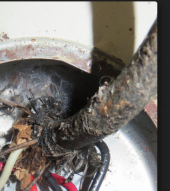Hedges
I See Electromagnetic Fields!
- Joined
- Mar 28, 2020
- Messages
- 20,505
I don't know what that means. Is that white wire a neutral or a ground or not part of the incoming feed?
I also see two of what seem to be uninsulated wires. The cable may have had red/black/white/bare and previous owner used white for ground. Replacement wire can be done according to convention.
Correct me if I am wrong but do you mean Watts or power? i thought wre size and current were irrespective of voltage?
Yes, except with fixed resistance and two choices of voltage, 240V will push twice the current through same heating element as 120V would. I'm just suggesting sizing the wire for current it would have to carry in case of 240V. Probably 10 awg.
Hedges was simply suggesting to size the wire for the full current draw at 240V so in the future its not necessary to pull a new cable. In the meantime 120V draw will be less so the wire is oversized during that time.
Yes.




